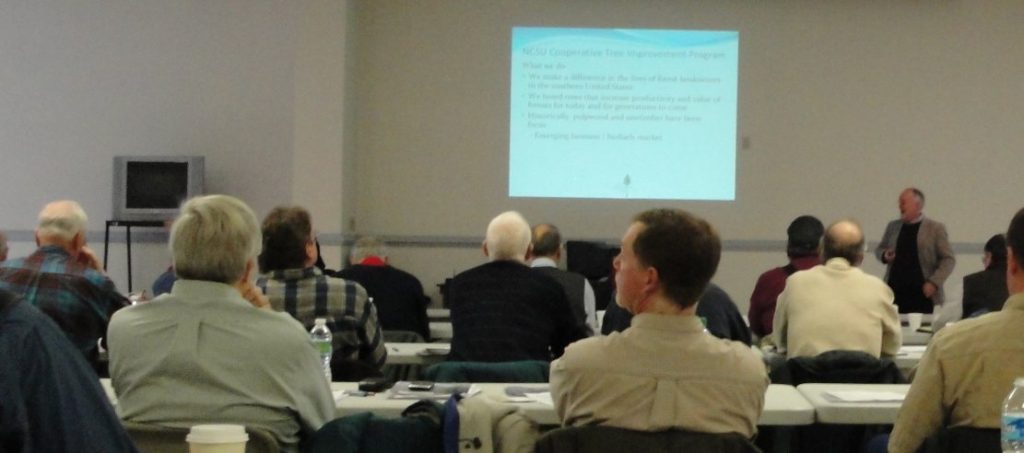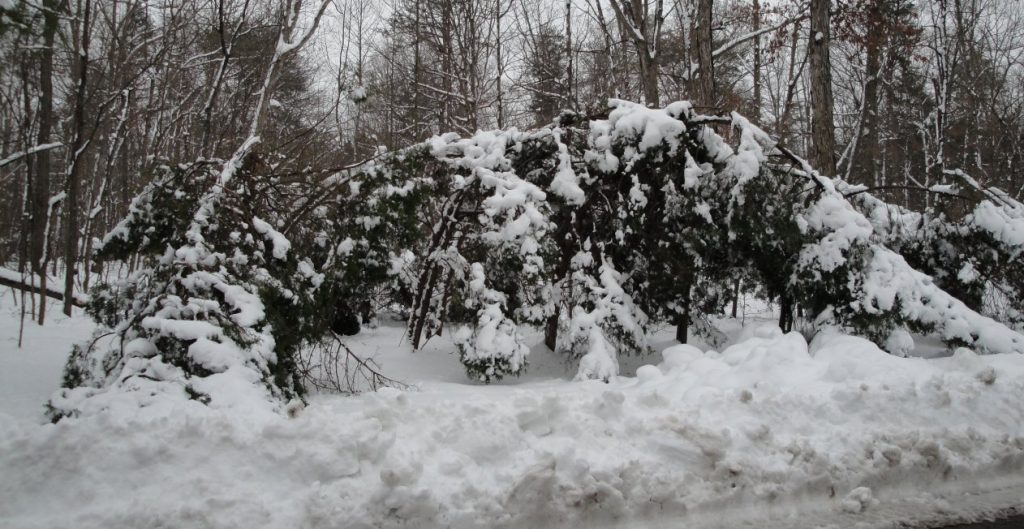The debate about whether heredity or environment is more important in shaping human behavior has been a hot topic for many years. The “blank slate” idea dominated thinking when I was on college and I remember being embarrassed by the castigation I got from one of my anthropology professors for suggesting that human events were influenced by genetics. We have reached a more nuanced understanding, but books like “The Blank Slate”, by Stephen Pinker still cause controversy. And suggesting innate differences among people can still get you in serious trouble in some places.

The tree and genetic determinism
So let me talk about genetic determinism in trees. Presumably none of them will be insulted or feel that I have diminished their self esteem. Getting the best genetic stock and managing it for optimal results (nature & nurture) was a topic at the Forest Landowners’ conference on forest productivity that I attended. They were going to hold it at the Virginia Department of Forestry in Charlottesville, but the snow knocked out the electricity, so they moved it to the Rivanna Volunteer Fire Department (above), where they have a big meeting room (below).

Both genetics and environment are important and they build on and affect each other. The anger of my anthropology professor just showed that he was not qualified to teach the subject. Unfortunately he was reflecting the mainstream scientific consensus of those times.
Genetic improvement changed forestry
Genetic improvements have greatly changed forestry in the last fifty years. This is especially true for loblolly pines, the most commonly planted timber tree in the South, which are unusually adaptable. The “original” loblolly is a fast growing but often crooked and ugly tree. Genetic improvement can be very simple. You just choose the trees with the best characteristics and try to plant more of them. We are now in the third generation of loblolly and the differences are remarkable.
The new trees take thirty years to get as the original trees get to be in eighty. They are also a lot straighter, more resistant to disease and have a better branching structure. You can achieve these goals in different ways. The easiest is the simple one I mentioned above. Just gather the seeds from the best trees; grow them and repeat. In this system the trees pollinate themselves, so there is randomness in this process. A next step is to control pollination to ensure that the best fertilize the best. This is more labor intensive, since you have to put little bags on the trees to be sure that only the right pollen gets to the right flowers.
Below are Virginia pines squashed by the snow. Virginia pines are weedy trees and not much use. They don’t live long and break easily. I saw lots of broken Virginia pines along the road.

Bring on the clones
The latest step is cloning. Let’s explain a little about cloning in plants, lest we think about a “Caprica” scenario. Most gardeners have cloned plants. You can clone a willow or a cottonwood just by shoving a stick into wet ground. If you see a bunch of cottonwoods along a river, there is a good chance that they are all the same tree – genetically – as trees sprouted from roots or from sticks that lodged in the mud. I once inadvertently cloned a cottonwood when I used a freshly-cut cottonwood branch as a marking stick. A couple days later it sprouted into a little tree. Pines are harder, but they can be done. The clones are all genetically identical, so they can be a good test for the nature v nurture question.
Good genetics can move the whole curve higher, but variation remains and good genetic are the most profitable deployed as other conditions improve. Many of the costs associated with establishing and managing the stand of trees remain the same no matter what you plant. If you are planning to expend a lot of energy and time on management and planning, you are well advised to spend a little more for genetically superior trees. All trees will do better with better management, but the better trees will do better than the others.
Improving conditions make good genes more important
In other words, the more you improve conditions and remove obstacles, the more import genetics becomes to the results and the greater the gap between the superior and the inferior trees. It makes sense when you think in terms of potential. It doesn’t make much difference if one tree has the genetic potential to grow 80 feet tall in twenty years while another can only grow 40, if limiting conditions prevent any of the trees from growing more than 30 feet tall.
Limiting factors
So what are some of the limiting factors? The most obvious are climate, rainfall, soil and elevation. These make a difference when choosing a site, but after that they are beyond our control. But there are many limiting factors that we can control, including spacing among the trees, thinning schedules, rotation timing, competition control & fertilization.
Spacing
Trees will grow faster and stronger if there is more space between them. It is like thinning flowers in a garden. Everything else being equal, a similar amount of wood will grow on a given piece of ground no matter how thick or thin the trees are planted, but the health and quality will be very different. If planted too thick, you will have lots of small, maybe worthless trees. The optimal number of trees per acre is still debated among foresters.
Some of it depends on your goal. If you want to produce lots of pulp, you might want to plant thick. If you are trying to grow saw timber, you need to plant thinner. Another consideration is that if the trees are close enough together, they will sooner shade out competition and also shade out lower branches so that the trees will essentially prune themselves, leaving wood with fewer knots.
Thinning
Thinning schedules are a type of spacing issue, but with additional considerations. Thinning does not have to be a random selection. You can take out the inferior trees when you thin, so thinning both produces more space, more sun, water etc, but also leaves the better trees.
Controlling competition
Competition control is crucial. If you don’t control hardwoods, they will out-compete pines in most situations. Some hardwoods, such as gum and tulip trees just grow faster, but hardwoods also often have the advantage of an established root system, since they sprout from stumps or roots even after many years of being shaded out. Hardwoods can be controlled with physical methods, such as cutting, but the best way to control hardwoods these days is chemical.
BasF makes a couple of products called “Chopper” and “Arsenal”. They kill most hardwoods but leave the pines. Unfortunately, they don’t work very well with herbaceous plants or with blackberries, which easily over top the little trees, but they still do a good job with the hardwood competition, which is the key.
It is smart to spray with Chopper when you are establishing a pine stand. After that, you can go in with backpack sprayers. The boys and I killed off a couple acres of invasive Ailanthus using hack and squirt (where you smack the stem with a machete and then squirt in some arsenal) and I still have to go after individuals constantly. The good thing for the landowner is that the prices of these chemical has plummeted, as they have gone off patent. IMO it is still good to buy the name brand because they support the product better and the name brand product is also fairly cheap.
Fertilization
Fertilization is still not much used in forestry but it can increase yields. Most forests in Virginia grow on bad soil, either naturally poor or depleted by bad farming practices of times past. (The key crops of Southern Virgina, cotton and tobacco, are hard on soils.) If the soil is good, the land is usually devoted to row crops, which pay more than trees. (An exception is recently converted tobacco land. When the government stopped supporting tobacco crops, many tobacco farmers left the business and the land has been planted in trees. These trees are only a few years old, but they seem to be growing well.)
Deficient Virginia soils
Virginia forest soils are almost always deficient in phosphorus and nitrogen and trees grow a lot faster when they are provided with them. You have to give both, since just providing one or the other doesn’t do much good. You can fertilize when the stand is established and or fertilize after 6-10 years. Until that time, there is usually enough P & N for the little trees.
I fertilized my CP property with biosolids in September 2008. It seems to have given them a good jump.
Anyway, those are some of the things I learned at the meeting. I have drifted a little from the nature versus nurture. I think both are important. We cannot choose between them, since it is nearly impossible to know where the effects of one stop and the other start and they actually change each other by being in contact. As the trees show, equalizing or improving opportunity and conditions will make genetics more – not less – important and will make inequality more – not less – acute. The trees don’t care; people might.
